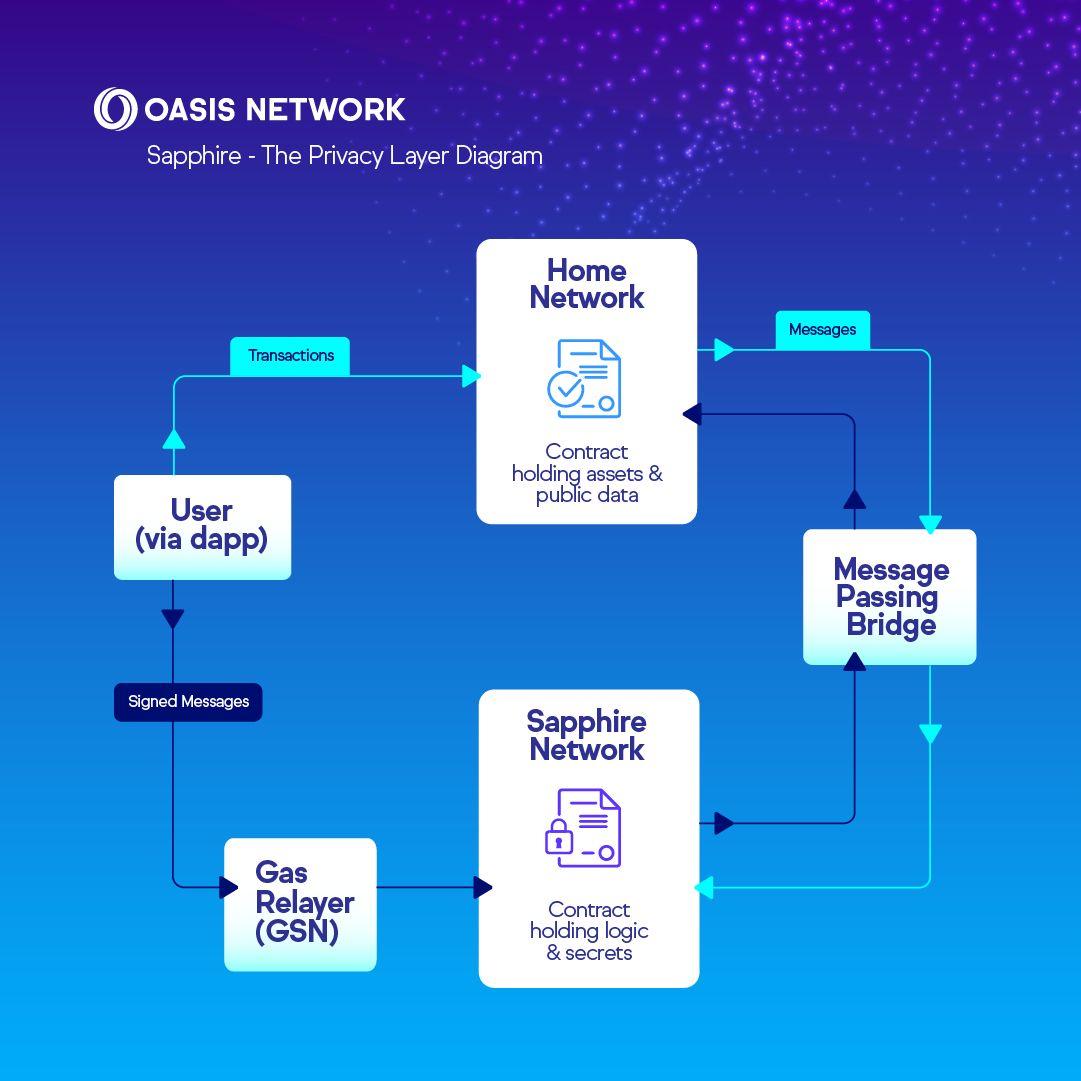Oasis Privacy Layer
The Oasis Privacy Layer (OPL) is an EVM-compatible privacy solution that empowers developers to add new functionality to smart contracts on the most popular EVM networks like Ethereum, BNB Chain, and Polygon with encrypted transactions and confidential state.
By using a Solidity library that integrates Sapphire into your existing and future Web3 applications, developers on any supported network can seamlessly add confidential state and selective disclosures to their dApps when using contract a deployed on Sapphire without leaving their existing networks.
For more information about OPL and to catch the latest news, please visit the official OPL page.

The user submits a transaction on the Home network to a contract which uses
postMessage to notify the SGN that it should approve the cross-chain message.
The Executor waits, when the SGN approves the message the Executor submits a
transaction to the target contract on Sapphire.
The Home Contract pays the SGN to watch and approve the message, but the Executor needs to be run by somebody willing to pay for the gas to submit transactions to the destination chain.
Quickstart
A pair of contracts are linked bidirectionally 1-1 to each other across chains, with one end on Sapphire and the other on a supported EVM-compatible chain (the Home Network). They can post and receive messages to & from each other using the message-passing bridge, but must register endpoints to define which messages they handle from each other.
Start by adding the @oasisprotocol/sapphire-contracts NPM package to your
Hardhat project so you can import OPL.sol:
- npm
- pnpm
- Yarn
npm install @oasisprotocol/sapphire-contracts
pnpm add @oasisprotocol/sapphire-contracts
yarn add @oasisprotocol/sapphire-contracts
Then define the two contracts, starting with a contract on Sapphire which runs
inside the confidential enclave and can be called via the secretExample
handler. Use the constructor to provide the Sapphire contract with the location
(address and chain) of the contract on the Home network:
import {Enclave, Result, autoswitch} from "@oasisprotocol/sapphire-contracts/contracts/OPL.sol";
contract SapphireContract is Enclave {
constructor(address otherEnd, string chain) Enclave(otherEnd, autoswitch(chain)) {
registerEndpoint("secretExample", on_example);
}
function on_example(bytes calldata _args) internal returns (Result) {
(uint256 a, bool b) = abi.decode(args, (uint256, bool));
// TODO: do confidential things here
return Result.Success;
}
}
Then on the other chain, define your contract which can be called via
triggerExample to send a message to the contract on Sapphire using the
postMessage interface.
import {Host, Result} from "@oasisprotocol/sapphire-contracts/contracts/OPL.sol";
contract HomeContract is Host {
constructor(address otherEnd) Host(otherEnd) {
}
function triggerExample (uint256 a, bool b) external payable {
postMessage("secretExample", abi.encode(a, b));
}
}
After a few minutes the bridge will detect and then the executor will invoke the
SapphireContract.on_example method.
Monitoring
The Celer IM Scan API can be used to retrieve status and message details by providing the globally unique transaction ID from the chain which originated the message.
https://api.celerscan.com/scan/searchByTxHash?tx=0x...
For details of the response format, see the Query IM Tx Status page of the Celer Inter-Chain Message (IM) documentation. Using this API lets you to check if messages have been delivered.
Mainnet Deployment
It is necessary to run a Message Executor which monitors the Celer State Guardian Network (SGN) for cross-chain messages and then submits the proof on-chain to deliver them to the target contract.
If you are participating in a Hackathon or Grant, please fill out the relay request form to be allowed to use the shared Message Executor.
Supported Networks
Mainnets
| Name | Int ID | Hex ID | autoswitch name |
|---|---|---|---|
| Ape | 16350 | 0x3fde | ape |
| Arbitrum Nova | 42170 | 0xa4ba | arbitrum-nova |
| Arbitrum One | 42161 | a4b1 | arbitrum-one |
| Astar | 592 | 0x250 | astar |
| Aurora | 1313161554 | 0x4e454152 | aurora |
| Avalanche | 43114 | 0xa86a | avalanche |
| Binance Smart Chain | 56 | 0x38 | bsc |
| Ethereum | 1 | 0x1 | ethereum |
| Fantom | 250 | 0xfa | fantom |
| Filecoin | 314 | 0x13a | filecoin |
| Milkomeda C1 | 2001 | 0x7d1 | milkomeda |
| Moonriver | 1285 | 0x505 | moonriver |
| Polygon | 137 | 0x89 | polygon |
| Sapphire | 23294 | 0x5afe | sapphire |
| Syscoin | 57 | 0x39 | syscoin |
| Polygon zkEVM | 1101 | 0x44d | polygon-zkevm |
| Optimism | 10 | 0xa | optimism |
| zkSync Era | 324 | 0x144 | zksync-era |
Testnets
| Name | Int ID | Hex ID | autoswitch name |
|---|---|---|---|
| Arbitrum Testnet | 421611 | 0x66eeb | arbitrum-testnet |
| Avalanche C-Chain Fuji Testnet | 43113 | 0xa869 | avalanche-fuji |
| BSC Testnet | 97 | 0x61 | bsc-testnet |
| ConsenSys zkEVM Testnet | 59140 | 0xe704 | zkevm-testnet |
| Dexalot Testnet | 432201 | 0x69849 | dexalot-testnet |
| Fantom Testnet | 4002 | 0xfa2 | fantom-testnet |
| Filecoin Hyperspace Testnet | 3141 | 0xc45 | filecoin-testnet |
| FNCY Testnet | 923018 | 0xe158a | fncy-testnet |
| Godwoken Testnet | 71401 | 0x116e9 | godwoken-testnet |
| Goerli Testnet | 5 | 0x5 | goerli |
| Polygon Mumbai Testnet | 80001 | 0x13881 | polygon-mumbai |
| Polygon zkEVM Testnet | 1442 | 0x5a2 | zkevm-testnet |
| Sapphire Testnet | 23295 | 0x5aff | sapphire-testnet |
| Scroll Alpha Testnet | 534353 | 0x82751 | scroll-testnet |
| Shibuya Testnet | 81 | 0x51 | shibuya-testnet |
In the following sections we will look at a concrete example on how to build a confidential, cross-chain DAO-voting dApp from scratch using the Oasis Privacy Layer!
